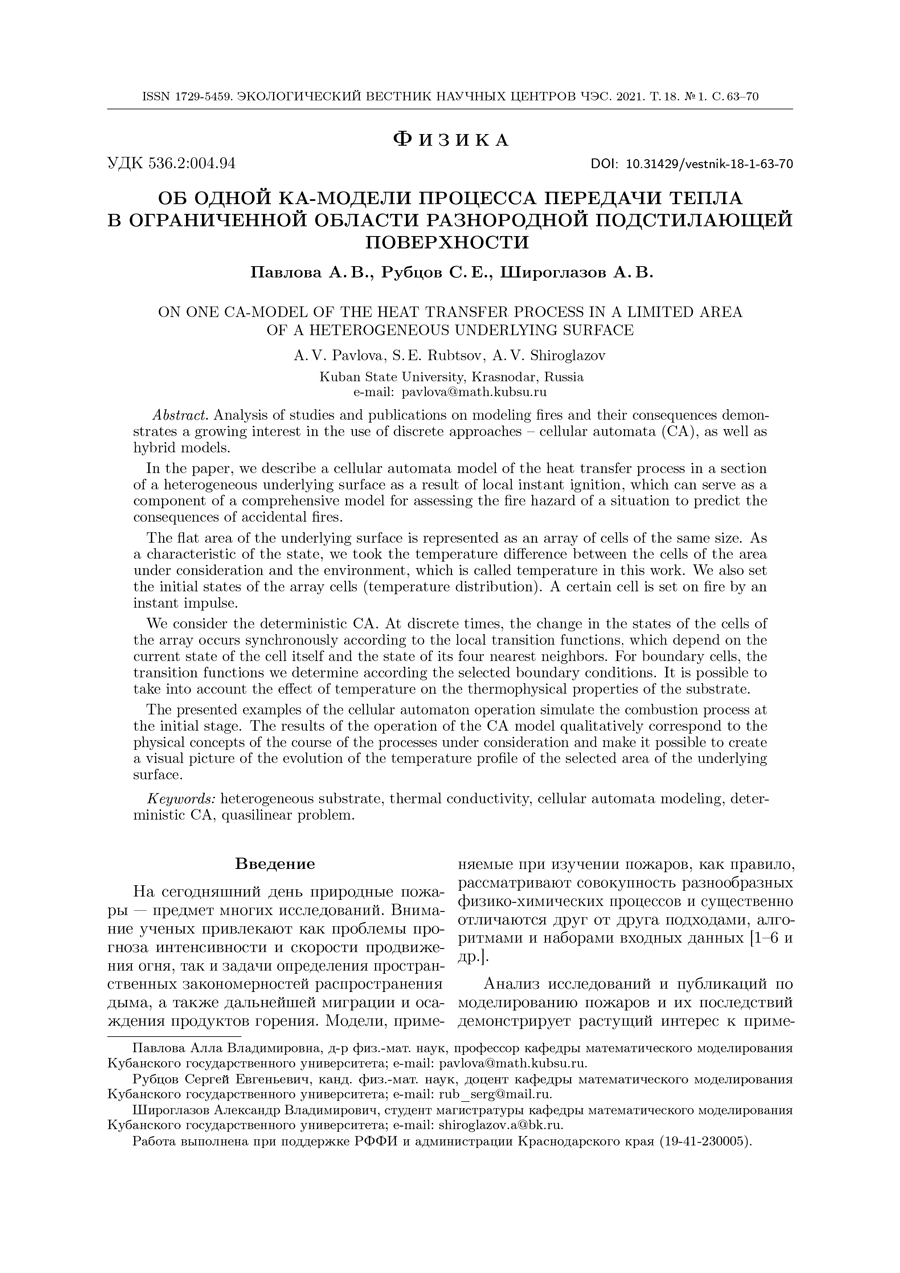On one CA-model of the heat transfer process in a limited area of a heterogeneous underlying surface
UDC
536.2:004.94DOI:
https://doi.org/10.31429/vestnik-18-1-63-70Abstract
Analysis of studies and publications on modeling fires and their consequences demonstrates a growing interest in the use of discrete approaches -- cellular automata (CA), as well as hybrid models.
In the paper, we describe a cellular automata model of the heat transfer process in a section of a heterogeneous underlying surface as a result of local instant ignition, which can serve as a component of a comprehensive model for assessing the fire hazard of a situation to predict the consequences of accidental fires.
The flat area of the underlying surface is represented as an array of cells of the same size. As a characteristic of the state, we took the temperature difference between the cells of the area under consideration and the environment, which is called temperature in this work. We also set the initial states of the array cells (temperature distribution). A certain cell is set on fire by an instant impulse.
We consider the deterministic CA. At discrete times, the change in the states of the cells of the array occurs synchronously according to the local transition functions, which depend on the current state of the cell itself and the state of its four nearest neighbors. For boundary cells, the transition functions we determine according the selected boundary conditions. It is possible to take into account the effect of temperature on the thermophysical properties of the substrate.
The presented examples of the cellular automaton operation simulate the combustion process at the initial stage. The results of the operation of the CA model qualitatively correspond to the physical concepts of the course of the processes under consideration and make it possible to create a visual picture of the evolution of the temperature profile of the selected area of the underlying surface.
Keywords:
heterogeneous substrate, thermal conductivity, cellular automata modeling, deterministic CA, quasilinear problemAcknowledgement
References
- Perminov, V.A. Matematicheskoe modelirovanie vozniknoveniya i rasprostraneniya verhovyh lesnyh pozharov v osrednennoj postanovke [Mathematical modeling of the occurrence and distribution of riding forest fires in the averaged setting]. Journal of technical physics, 2015, vol. 85, iss. 2, pp. 24–30. (In Russian).
- Asylbaev, N.A. Matematicheskoe modelirovanie rasprostraneniya stepnogo pozhara [Mathematical modeling of the spread of steppe fire]. Computer Research and Modeling, 2010, vol. 2, no. 4, pp. 377–384. (In Russian).
- Barovik, D.V., Taranchuk, V.B. Algoritmicheskie osnovy postroeniya komp'yuternoj modeli prognoza rasprostraneniya lesnyh pozharov [Algorithmic foundations for constructing a computer model for predicting the spread of forest fires]. Fundamental Sciences. Informatics, 2011, no. 12, pp. 51–56. (In Russian).
- Aloyan, A.E., Harutyunyan, V.O. Modelirovanie dinamiki aerozolej i formirovaniya oblachnosti pri lesnyh pozharah [Modeling the dynamics of aerosols and the formation of clouds during forest fires]. Ecological Bulletin of Research Centers of the Black Sea Economic Cooperation, 2008, no. 3, pp. 5–19. (In Russian).
- Kourtz, P.H., O'Regan, W.G. A model for a small forest fire to simulate burned and burning areas for use in a detection model. Forest Science, 1971, vol. 17, iss. 2. P. 163–169.
- Alexandridis, A. et al. A cellular automata model for forest fire spread prediction: The case of the wildfire that swept through Spetses Island in 1990. Applied Mathematics and Computation, 2008, vol. 204, no. 1, pp. 191–201.
- Finney, M.A. FARSITE: Fire Area Simulator. Model Development and Evaluation. USDA For. Serv. Res. Pap. RMRS-RP-4. 1989.
- Freire, J.G., DaCamara, C.C. Using cellular automata to simulate wildfire propagation and to assist in fire management. Natural Hazards and Eath Systems Sciences, 2019, vol. 19, pp. 169–179.
- Rudnickij, V.N., Mel'nikova, E.A., Pustovit, M.O. Rasparallelivanie i optimizaciya vypolneniya raschetov processa razvitiya pozhara na osnove trekhmernyh kletochnyh avtomatov [Parallelization and optimization of the calculations of the process of fire development based on three-dimensional cellular automata]. Vektornauki TGU [Vector science TSU], 2014, no. 1, pp. 22–26. (In Russian).
- Trunfio, G.A. Predicting wildfire spreading through a hexagonal cellular automata model. Lecture Notes in Computer Science, 2004, vol. 3305, pp. 385–394.
- Pavlova, A.V., Rubtsov, S.E., Rodionov, P.R. Ispol'zovanie kletochno-avtomatnyh modelej v issledovanii rasprostraneniya pozhara pri razlive nefteproduktov na poverhnosti pochv [The use of cellular automata models in the study of the spread of fire during the spill of oil products on the soil surface]. Zashchita okruzhayushchej sredy v neftegazovomkomplekse [Environmental Protection in the Oil and Gas Complex], 2020, no. 1, pp. 54–59. (In Russian).
- Gladskoy, I.B., Pavlova, A.V., Rubtsov, S.E. K modelirovaniyu rasprostraneniya prirodnyh pozharov s ispol'zovaniem GIS-tekhnologij [On modeling the spread of wildfires using GIS technologies]. Ecological Bulletin of Research Centers of the Black Sea Economic Cooperation, 2019, vol. 16, no. 4, pp. 13–21. (In Russian)
- Bobkov, S.P., CHernyavskaya, A.S. Modelirovanie nelinejnoj teploprovodnosti diskretnymi metodami [Modeling of nonlinear thermal conductivity by discrete methods]. Vestnik ISEU. 2018. iss. 3, pp. 64–70.
- Safonov, M.A., Vakurov, A.D. Ogon' v lesu [Fire in the forest]. Nauka, Novosibirsk, 1981. (In Russian)
Downloads
Submitted
Published
How to Cite
Copyright (c) 2021 Pavlova A.V., Rubtsov S.E., Shiroglazov A.V.

This work is licensed under a Creative Commons Attribution 4.0 International License.




